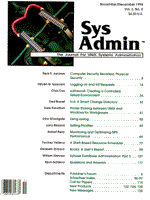
Sidebar: Setting Up a Remote Printer in UNIX with lp
When a print request is sent to a UNIX printer, the name of the print file is passed as an argument to what UNIX calls a printer interface file. In SCO UNIX 3.4.2, this file resides in the /usr/spool/lp/admins/lp/interfaces directory. A printer interface file exists for each printer defined on the system. The printer that I was setting up didn't really exist for the UNIX machine; it was a local printer to a PC out on the network. I needed to find a way to set up the printer in UNIX. Normally SCO handles remote printers via its LPR/LPD print utilities rather than the standard lp command. Since we could not find a version of LPR/LPD that worked correctly with Windows for Workgroups, we decided to use remote copy, rcp, to copy the print file over to the remote PC. Once the print file was successfully copied, the remote PC used another program, WinSpool, to send the file to its printer. When setting up printers in SCO's sysadmsh, you must specify the device that the printer is connected to. Since the remote printer was not connected to the UNIX machine at all, I specified the /dev/null device. The next task was to modify the printer interface file that was created for this printer. I did not want the standard interface file because the purpose of that file is to redirect the print file out to the printer's device. Since I had assigned the /dev/null device for this printer, this meant I would never get any output. Instead, I wanted to modify the interface file so that it would use the rcp command to copy the print file over to the remote system. Listing 1 is a printout of the interface file for the remote printer. Its purpose is to send the print file to a remote machine whose name is sales1. sales1's IP address is defined in the /etc/hosts file. The method I use for naming the file on the remote machine might need further explanation. I give the file on the remote machine the same name as the filename in UNIX. However, because of this, if the user requests multiple print copies of that one file, I will have to copy the file multiple times, once for each copy that is to be made. Thus, the file name on the remote machine had to be unique in order to keep it from being overwritten in cases where multiple copies were requested. The uniqueness is derived by prefixing the file name with a loop counter. This way I could still keep the filenames the same on both machines, but the remote machine's filename would be prefixed with the copy number.
|